同济大学实用写作期末复习提纲
大学生实用写作考试复习资料.doc11111

大学生实用写作考试复习资料:一、绪论(一)应用文的概念:应用文是以实际应用为目的,有比较固定的格式,语言平实、规范、典雅,直接用于处理公私事务的文章。
1、事务:①具体工作;日常工作②某项专门性业务;2、事物:客观存在的所有物体和现象。
3、权力:①政治方面的强制力量,国家权力,权力机关;②个人或机构在职责范围内的领导和支配权。
4、权利:公民依法享有的利益。
政治权利。
(二)应用文的特点1.实用性强 2.读者对象明确 3.应用广泛 4.格式相对固定5.时限性强。
最大的特点:实际应用性(三)《尚书》是我国最早的应用文写作专集,其内容包括虞夏商周四个朝代的祝词、誓词、诰言、法令及一些历史事迹。
应用文的高峰期——唐、宋(四)唐宋:名称有变化,格式更完善并趋于固定。
1、唐宋应用文体式规范、文优字美,对书写的要求更细致。
2、唐宋应用文杰作迭出、风格多样。
(五)判断正误1.应用文最显著的特点在于它的实际应用性。
2.“一国两制”的构想在当时是一个新生事务。
3.秘书要掌握事务性工作的处理方法和技巧。
4.领导人物要注意不能滥用手中的权利。
5.武汉大学弱者权力保护中心向全社会征募志愿者。
6.我国最早的应用写作专集是《春秋》。
7.元明清时期是我国应用文发展的高峰时期。
8.应用文的表达方式只能使用叙述、议论和说明。
(六)主题的概念:主题的含义:主题这个词起源于德国,最早它是一个音乐术语,表达的是乐曲中的主要旋律。
在文学创作中,主题是指通过具体艺术形象所表现的、在作品中起主导作用的基本思想。
文学作品的主题可以分为广义和狭义两种。
文学的广义主题是指在文学中具有普遍性、反映生活本质的基本思想,如爱情、思乡、死亡、自我追寻等,它们在不同时代、不同民族的文学艺术作品中反复出现,因此也被称为文学的“母题”(motif)。
中国文学的四大主题:(一)生命体悟(二)爱情(三)隐逸(四)思乡文学的狭义主题是指由一些具体作品所表现出的思想意蕴出发,概括出所反映的思想意义和作家对于这种生活现象的认识和评价。
大学《实用写作》期末知识要点总结

大学《实用写作》期末总复习重点资料整理(重庆师范大学政治学院2010级思政二班石盼)第一章第一节1.我国应用写作的萌生期:原始社会氏族公社后期2.我国应用文正式产生的标志: 应用文雏形:从1898年起在河南安阳殷虚遗址陆续发掘出的甲骨刻辞。
3.甲骨刻辞、钟鼎铭文、《尚书》在我国应用文发展中的地位甲骨刻辞:应用文雏形,商王朝的公务文书,我国最早的应用文。
钟鼎铭文:我国最早的私物文书。
《尚书》:我国现存最早且保存完好的一部应用文总集。
4.把握我国各历史发展阶段在应用文发展史中的特点(每部分开始阐述的标志性的语句)(1)应用写作萌生——原始社会氏族公社后期(2)应用文雏形出现——商周时期(3)应用文文体成型与文书制度创立——秦汉时期(4)应用文写作的自觉与理论建立——魏晋南北朝时期(5)应用文写作的成熟——唐宋时期(6)应用文写作——元明清时期(7)应用文的更革与新变——辛亥革命至新中国成立前(8)应用文写作大发展与新的繁荣——新中国成立至今5.公文称谓出现的时期:汉代6.魏晋南北朝时期出现的重要应用文理论著作及其作者曹丕《典论*论文》,挚虞《文章流别论》,陆机《文赋》,刘勰《文心雕龙》,蔡邕《独断》,曹植《与杨德祖书》,任昉《文章缘起》,曹操《让县自明本志令》,诸葛亮《出师表》,李密《陈情表》,王羲之《与桓温笺》7.一文一事制度创立的时期:唐宋两代8.应用文一词出现的时期及依据:北宋苏轼《答刘巨济书》9.北洋政府“新公文程式”对“公文”概念的界定:凡处理公事之文件曰公文第二节应用文的含义:应用文是指国家机关、企事业单位、社会团体、人民群众在日常生活、学习、工作中处理公共事务或私人事务所使用的具有某种惯用格式和直接应用价值的文章。
1.应用文的特点(1). 实用性(最根本特点) (2). 模式性:有固定的结构和格式;(3)真实性:表现在语言方面 (4).时效性(方面:时代性、及时性、作用时间的有限性)2.应用文的作用(1).明法传令,处理事务 (2).实施管理,维护秩序(3).协调沟通,促进交流 (4).凭证依据,文献参考第三节1.应用文主旨的要求:正确、鲜明、集中2.主旨表达的主要方法(1).标题彰显主旨(2).开篇开宗明义(3).结尾归结主旨(4).领句概括主旨第四节1.应用文的标题、开头、结尾的写作方式标题:公文式标题、论文式标题、新闻式标题、文种式标题开头:缘由式(原因式、目的式、依据式、合并式)、引据式、情况概述式、结论式、问候祝贺式、背景交代式结尾:执行要求式2.应用文语言的特点和基本要求特点:通用性的书面语体、沿用模式化语词和句式、合理使用书面辅助语言基本要求:准确、简洁、朴实、得体。
实用写作考试重点
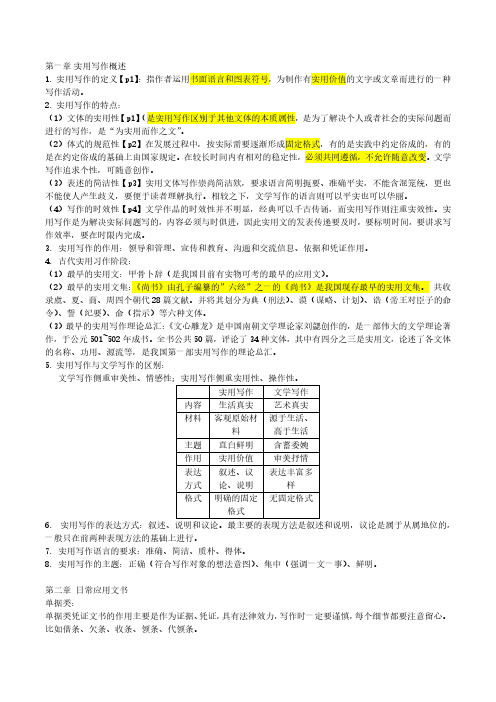
是在约定俗成的基础上由国家规定。在较长时间内有相对的稳定性,必须共同遵循,不允许随意改变。文学
写作追求个性,可随意创作。
(3)表述的简洁性【p3】实用文体写作崇尚简洁欸,要求语言简明扼要、准确平实,不能含混笼统,更也
不能使人产生歧义,要便于读者理解执行。相较之下,文学写作的语言则可以平实也可以华丽。
(4)写作的时效性【p4】文学作品的时效性并不明显,经典可以千古传诵,而实用写作则注重实效性。实
用写作是为解决实际问题写的,内容必须与时俱进,因此实用文的发表传递要及时,要标明时间,要讲求写
作效率,要在时限内完成。
3. 实用写作的作用:领导和管理、宣传和教育、沟通和交流信息、依据和凭证作用。
4. 古代实用习作阶段:
第一章 实用写作概述
1. 实用写作的定义【p1】:指作者运用书面语言和图表符号,为制作有实用价值的文字或文章而进行的一种
写作活动。
2. 实用写作的特点:
(1)文体的实用性【p1】(是实用写作区别于其他文体的本质属性,是为了解决个人或者社会的实际问题而
进行的写作,是“为实用而作之文”。
(2)体式的规范性【p2】在发展过程中,按实际需要逐渐形成固定格式,有的是实践中约定俗成的,有的
第三章 公务文书 从 2012 年 7 月 1 日起,党政机关公文都要参照《党政机关公文处理工作条例》的要求执行一共 15 种。 按行文关系 上行文:下级机关向它所属的上级领导或者指导机关发送的公文,比如请示、报告、议案等 平行文:平级机关或不相隶属的机关之间相互往来的公文,比如函
下行文:上级领导或指导机关向下级机关的发文,如命令(令)、决定、决议、批复、公报、公告、通告、 通报、通知 按公文的性质作用可分为四大类 指挥性公文:命令(令)、决定、决议、批复 报请性公文:请示、报告、议案 知照性公文:公报、公告、通告、通报、通知、函、意见 记录性公文:纪要 按保密程度: 按公文的机密程度,可分为绝密、机密、秘密公文。 按紧急程度 按照公文的紧急程度,可以分为两类,特急公文和加急公文。 行政公文的格式组成 行政公文格式分版头、主体、版记三部分。 版头七要素:公文份号、秘密等级和保密期限、紧急程度、发文机关标志、发文字号、签发人、分割线 版记三要素:分割线、抄送机关、印发机关和印发时间 发文机关标志由发文机关全称或规范化简称后面加“文件”组成 发文字号由发文机关代字、年份、发文顺序号组成,联合行文时使用主办机关的发文字号。 年份应标全称,用六角括号〔〕括入,不能用圆括号或方括号;发文顺序号不加第字,不编虚位(1 不编 01), 在阿拉伯数字后面加“号”字 签发人 为了表明对公文内容负责 ,便于查明责任,按规定下级机关上报给上级机关的公文,业务主管部门上报给 领导机关的公文,即上行文应注明签发(会签)人以示负责。平行文和下行文则不要求注明签发人。 公文标题 公文标题的三要素
实用写作期末复习
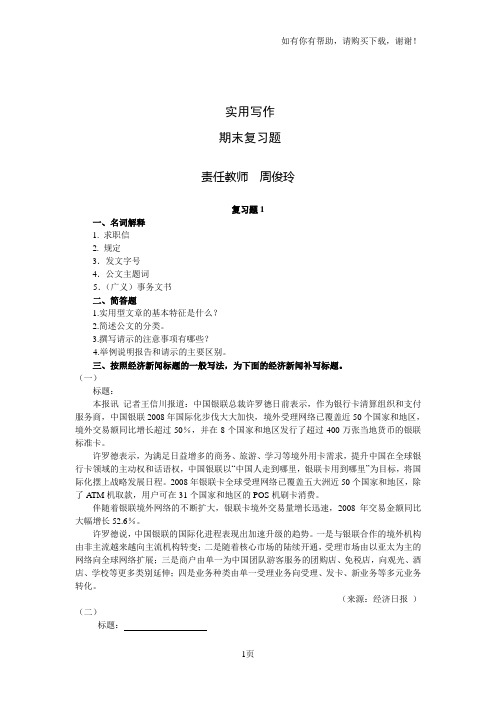
实用写作期末复习题责任教师周俊玲复习题1一、名词解释1. 求职信2. 规定3.发文字号4.公文主题词5.(广义)事务文书二、简答题1.实用型文章的基本特征是什么?2.简述公文的分类。
3.撰写请示的注意事项有哪些?4.举例说明报告和请示的主要区别。
三、按照经济新闻标题的一般写法,为下面的经济新闻补写标题。
(一)标题:本报讯记者王信川报道:中国银联总裁许罗德日前表示,作为银行卡清算组织和支付服务商,中国银联2008年国际化步伐大大加快,境外受理网络已覆盖近50个国家和地区,境外交易额同比增长超过50%,并在8个国家和地区发行了超过400万张当地货币的银联标准卡。
许罗德表示,为满足日益增多的商务、旅游、学习等境外用卡需求,提升中国在全球银行卡领域的主动权和话语权,中国银联以“中国人走到哪里,银联卡用到哪里”为目标,将国际化摆上战略发展日程。
2008年银联卡全球受理网络已覆盖五大洲近50个国家和地区,除了ATM机取款,用户可在31个国家和地区的POS机刷卡消费。
伴随着银联境外网络的不断扩大,银联卡境外交易量增长迅速,2008年交易金额同比大幅增长52.6%。
许罗德说,中国银联的国际化进程表现出加速升级的趋势。
一是与银联合作的境外机构由非主流越来越向主流机构转变;二是随着核心市场的陆续开通,受理市场由以亚太为主的网络向全球网络扩展;三是商户由单一为中国团队游客服务的团购店、免税店,向观光、酒店、学校等更多类别延伸;四是业务种类由单一受理业务向受理、发卡、新业务等多元业务转化。
(来源:经济日报)(二)标题:本报讯(记者李丹)11月9日,第三届泛珠三角区域环保产业技术交流洽谈会在成都举行,来自广东、福建、江西、湖南、广西、海南、贵州、云南等8省(区)政府和香港、澳门特别行政区的200多家环保企业代表纷纷来蓉寻找商机。
标题:“我们的污水处理技术可以在高原、高寒等地区正常使用。
”参展的四川一家环境工程公司负责人说,高原、高寒地区由于缺氧、温差大,用于污水处理的微生物很难培养,污水处理厂建设容易运行困难。
大学生实用写作复习资料

大学生实用写作复习资料1. 引言写作是大学生必备的核心能力之一。
在大学期间,学生们需要通过各种写作任务来表达自己的观点、沟通思想以及展示所学知识。
然而,很多大学生在写作方面存在一定困惑和不足。
为了帮助大学生提升写作技巧,本文提供一些实用的复习资料,涵盖写作的基础知识、写作流程以及常见写作问题的解决方案。
2. 写作的基本要素2.1. 主题句主题句是文章中的核心句子,它概括了文章的中心思想和要点。
良好的主题句能够帮助读者迅速理解文章的主旨,并为后续内容提供一个明确的框架。
在准备写作之前,大学生应该花时间思考并编写一个清晰的主题句。
2.2. 段落结构一个好的段落结构能够使文章的结构清晰,并帮助读者更好地理解作者的观点。
一个段落通常包含一个主题句和支持该主题句的相关论据、证据或例子。
大学生在写作时应该注意段落的逻辑关系和过渡,以确保文章的连贯性和流畅性。
2.3. 逻辑连接词逻辑连接词在写作中起到了桥梁的作用,能够使文章的结构更加紧密和连贯。
通过使用逻辑连接词,大学生能够表达出观点之间的关系,如因果关系、对比关系、并列关系等。
一些常见的逻辑连接词包括:因此、然而、另外、例如等。
3. 写作流程3.1. 计划在开始写作之前,制定一个写作计划非常重要。
首先,明确写作的目的和受众。
其次,分析和组织素材,确定文章的结构和大纲。
最后,给每个段落和主题句编写一个草稿,以便后续的修改和完善。
3.2. 写作在写作过程中,大学生应该始终保持清晰和简洁的表达。
避免使用复杂的词汇和句子结构,同时注意使用恰当的术语和语言风格。
此外,大学生应该注重文章的逻辑和流畅性,通过合理的过渡和段落结构来提升写作质量。
3.3. 修改和完善写完初稿后,大学生应该进行反复的修改和完善。
在修改过程中,要注意文章的逻辑关系、表达的准确性和语法的正确性。
此外,还可以通过请他人审阅提供宝贵的建议,并进行修正。
4. 常见写作问题及解决方案4.1. 内容不准确或不完整一些大学生在写作时可能存在内容不准确或不完整的问题。
大学写作复习提纲整理完整版

文章是通过对语言(材料、句段)的选择、组织和表达、交流信息的秩序体。
2、写作定义写作是作者为实现写作功能而运用思维操作技术和书面语言符号,对表达内容进行语境化展开的修辞性精神创造行为;是人类运用语言文字创造生命存在自由秩序的建筑行为、活动。
3、主题定义主题是作者运用各种材料和表现形式所传达出来的基本思路或基本观点;同时,主题又是读者对文章中心内涵的一种自我了理解,这种理解的深度和广度,常常和读者本人的文化背景、人生经历、知识结构、审美意识、情操境界等因素有关。
4、材料定义材料是作者为了写作的需要,从生活中提取、搜集到的一系列事实现象和理论依据。
简单来说,凡是用来表现主题的事物与观念都可称为材料。
5、结构定义文章的结构是文章部分与部分、部分与整体之间的内在联系和外部联系的统一。
6、过渡定义过渡是指体现段落与段落、层次和层次等各种衔接关系的形式或手段。
照应是指文章内容的前呼后应。
8、线索定义线索是把文章各个部分、各种内容有机地整合起来的一条线,是贯穿全文使结构井然有序的一种结构手法。
9、叙述定义叙述是把人物的经历和事物的发展变化的过程表现出来的一种写作方法。
10、描写定义描写就是对人物、事件和环境进行具体细致的描绘和刻画。
描写是文学中最基本、最生动的东西,是文学作品最感染人的地方。
11、抒情定义抒情是指用来表现和抒发作者和作品中人物的主观情感的表达方法。
12、议论定义议论即评议论说、讲道理。
作者通过事实材料和逻辑推理来阐明自己的观点,表明赞成什么或反对什么。
13、说明定义说明是用言简易明的文字,把事物的形状、性质、特征、成因、关系、功用等,解释清楚;或者把人物的经历、特征等表述明白的方法。
14、文学定义文学是艺术的基本形式之一,它是显示在话语蕴藉中的审美意识形态,以语言文字为媒介和手段塑造艺术形象,反映现实生活,表现人们的精神世界,通过审美的方式发挥其多方面的社会作用。
15小说定义小说是一种运用文学语言,以叙述为要表达方式,通过完整的故事情节的安排、典型形象的塑造和典型环境的描写,多方面地反映和再现现实生活的一种文学体裁。
大学写作复习提纲

大学写作提纲第一章1.材料,是指被写作者用来提炼和表现文本思想的那些事实,现象,理论,言论,数据等。
(材料就是作者为特定的写作目的而收集的一系列事实现象和理论依据)2.材料的类别:事实性材料(客观存在的现实或者材料所反映的事物,包括历史记载,统计数据,实际发生的事件,神话传说,科学幻想,自编的故事)和观念性材料(被社会实践证明了的理论知识和方法,包括各种理论,观念,常识和法则)。
3.文学作品的材料和实用性文章材料的不同特点①真实性:艺术真实和生活真实②在文章中所处的地位不同:主导地位和从属地位③选材的范围不同:广泛自由和严格限制4.选材的原则和要求:切题,真实,典型,新鲜5.材料加工的方法:综合,概括,释义,组织第二章1.主题即文章内容基本观点或核心思想2.立意的原则与要求:真诚,正确,集中,深刻,新颖3.文本思想的提炼与表象①炼意的途径:在尽可能全面掌握材料的基础上提炼思想在向事物内在纵深层面的挖掘中提炼思想在多种结论的比较选择中提炼思想②文本思想的表现:直接表意(看书p37-p38)间接表意第三章1.构思是指整个写作过程中的一系列思维活动,是一种创造性的思维活动,具有强调独创性和新颖性的特点。
2.结构是文本内部的组织构造。
(主题是文章的灵魂,文字是文章的细胞,材料是文章的血肉,结构就是文章的骨骼)3.结构安排的原则:整体性原则,适应性原则,创新性原则。
(p49-52)4.文章结构的基本内容:层次,段落,开头,结尾,过渡,照应,5.思维拓展的方法:顺向思维,逆向思维(求异思维),纵向思维(按时间顺序或事物发展的顺序),横向思维(把所关注的事物置放到普遍联系和相互作用的过程中,考虑事物运动特点和规律性),发散思维(多角度)(p61-p64)6.锻炼思路和组织思路的方法:拓展法(↑),挖掘法,控制法(收敛思维即求同思维),梳理法(拟写提纲)(p64-p66)第四章1.语言的作用和特性(看书,仔细看!p79-p80)2.立象,就是借用其他的事物来比拟,暗示,以帮助,启发读者去理解,这实际上是一种简介表达法。
《实用文体写作》复习资料

《实用文体写作》复习资料
绪论
第一章
常见行政公文
第二章事务文书
常用事务文书的写法
第三章公关文书
常见公关文书知识
说明:下面的第四章财经文书与第五章的法律文书均属于专用文书(又称为专业文书)。
专用文书还包括本书未涉及到的军事类文书、涉外类(外交、外事、外经等)文书、科技类文书、教育类文书等等。
第四章财经文书常见财经文书知识
第五章法律文书
各类诉讼文书涵义与用途
主要民事诉讼文书知识
主要刑事诉讼文书知识
主要行政诉讼文书知识
第六章生活文书
常见生活文书知识
考题类型及分数比重大致为:填空题(20%);名词解释题(10%);简答题(20%);文章分析题(20%);给材料作文30%.。
实用写作复习资料

《实用写作》复习资料实用文具有实用性、程序性和时效性三个特点。
实用文写作要经历准备、构思、表达和修改等四个阶段。
实用写作主要使用叙述、说明和议论三种表达方式。
应用文书要求主旨要正确、鲜明和集中地体现领导意图。
收集材料的方法有观察、调查和查阅。
⏹二、实用文的作用(一)法规准绳作用(二)指挥管理作用(三)联系知照作用(四)宣传教育作用(五)凭证依据作用⏹材料是体现文章主题的感性形态的具体材料和理性形态的抽象材料的总称。
材料的整理:1.分类法2.分析法3.综合法行政公文的种类(共13种)⏹1.命令(令)命令(令)是国家机关及其领导人颁布的具有强制性的文件,一般分为发布令、行政令、嘉奖令和任免令等。
⏹2.决定决定适用于对重要事项或者重大行动做出安排,奖惩有关单位及人员,变更或者撤销下级机关不适当的决定事项。
⏹3.公告公告“适用于向国内外宣布重要事项或法定事项。
”⏹4.通告通告“适用于公布社会各有关方面应当遵守或周知的事项。
”⏹5.议案议案“适用于各级人民政府按照法律程序向同级人民代表大会或人民代表大会常务委员会提请审议事项。
”行文规则⏹《国家行政机关公文处理办法》中规定使用的13种行政公文,按照不同标准,可以划分不同种类。
按行文方向(即文件走向)划分:有上行文、平行文和下行文三种。
上行文是下级机关向直属上级机关报送的公文,有请示、报告和意见。
下行文是上级机关向所属下级机关发送的公文,有命(令)、决定、公告、通告、通知、通报、批复、意见、会议纪要。
⏹四、行政公文的格式⏹行政公文的格式有文面格式和用纸、印装格式两种。
⏹(一)公文的文面格式⏹1.文头部分⏹(1)版头由发文机关名称加“文件”二字组成。
⏹(2)发文字号为便于登记、管理而编的序号。
⏹(3)签发人和会签人⏹(4)份号只用于大量印发或有密级的公文。
⏹(5)秘密等级分为“绝密”、“机密”和“秘密”。
⏹(6)紧急程度。
根据紧急程度分别标明“特急”或“急件”字样。
实用写作复习资料(开专)

(开放专科)《实用写作》期末考试复习要点一、考试使用教材说明:《实用写作》课程使用由中央电大出版社出版、任鹰主编地《实用写作教程》.二、考试题型介绍:、单项选择题:(分)、简答题:(分);、写作部分:(分);三、考试形式:考试形式为闭卷.四、复习范围:(一)、单项选择题:、实用文体是各类实用型文章地总称,而实用型文章与()文章相对地.、学术型文章、欣赏型文章、论述型文章、创造型文章、按照行文关系和行文方向,命令、决定等属于()、上行文、平行文、下行文、泛行文、行政公文又称(),对其种类、用途和格式,有关机构或部门均有专门地规定.、公务文书、事务文书、常用文书、法定文书、一切文章地构成要素是().、主旨材料结构语言、标题主旨材料语言、主旨符号结构语言、材料结构语言注释、表彰先进.批评错误,传达重要精神或者情况,可用()、公告、请示、报告、通报、不属于调查报告地特点地是()、真实性、技巧性、针对性、典型性、公文标题应该准确、简要,一般来说,不同形式地公文标题都应具备地要素是()、发文机关名称、发文事由、公文种类、发文时间、按照机密等级不同,将有保密要求地文件进行分类,下列哪项不属于这种分类().、绝密、保密、机密、秘密、文种地选用,除了发文目地和公文内容外,还需要考虑地一个因素是()、发文时间、行文关系、政策法规、制发过程、下列哪个选项不属于会议纪要写作地注意事项()、字体工整、纪实性提要性、要做好会议记录、要突出会议地要点、按其内容和功用地不同,可将通知分为指示性通知、批示性通知、告之性通知和()等几种.、任免性通知、颁发型通知、转发型通知、批转型通知、根据具体用途不同,下面各种类型中不属于通报地是()、表彰性通报、批评性通报、传达性通报、指令性通报、下面各种方式不属于公文正文开头写法方式地是()、指令式、说明式、期望式、祈请式、写作请示需注意()、可任意选用文种、可多头请示、可越级请示、做到一文一事、()地用途比较广泛,它可以用以总结一个单位,一个部门,甚至一个地区地经验,也可以用以揭露某一方面地问题,或者探明某一个事件地真相,还可以用以介绍某个事物地发展过程.文档来自于网络搜索、调查报告、事务文书、总结报告、常用文书、调查地方式很多,()是最传统地调查方式.、开会调查、采访、问卷、研究、在各种调查方法中,()地科学性和实用性都更强一些,因而采用这种调查方法地人越来越多.、普遍调查、重点调查、典型调查、抽样调查、合同地特点是()、合法性合意性平等性规范性、合法性优先性平等性规范性、合意性合法性平等性随意性、合意性优先性平等性规范性、启事地内容特征是()、时效性、简短性、告知性、真实性、在语言上调查报告通常采用()地叙述方式叙述事实.、第一人称、第二人称、第三人称、多视角综合、感情色彩较为浓烈,措辞热情、庄重,是()地重要特征.、贺电和贺信、慰问电和慰问信、唁电和唁函、感谢信和表扬信、一般来说,由封面和内文两部分组成地公关文书是()、贺信、请柬、条据、聘书、下面各组成部分,不属于求职信正文内容地是()、求职意愿、个人简历、求职者地特长和专长、目标岗位、既要能高度概括新闻事实,又要新颖独特,要能起到吸引读者作用地是新闻地()部分.、标题、导语、正文、结尾、合同不仅要反映当事人各方面地利益,也要反映当事人各方面地责任和义务,这是强调合同地().文档来自于网络搜索、合法性、合意性、平等性、规范性、合同地中心内容是().、数量、质量、价款、标地(三)、简答题部分:、简述总结地含义、并阐述总结地写作要求.、事务文书地特点与作用、简述计划地含义、并阐述制订计划地要求.、经济新闻地含义、特点、计划地作用主要体现在几个方面?、简述调查报告地含义、特点、并阐述调查报告地写作要求.、产品说明书地作用主要体现在哪几方面?、什么是合同?合同地特点有哪些?、通报地特点.?(四)、写作部分:主要对以下几个文种进行写作练习.、请示;、函;、会议通知;、欢迎词.。
写作学期末复习资料(精美版)
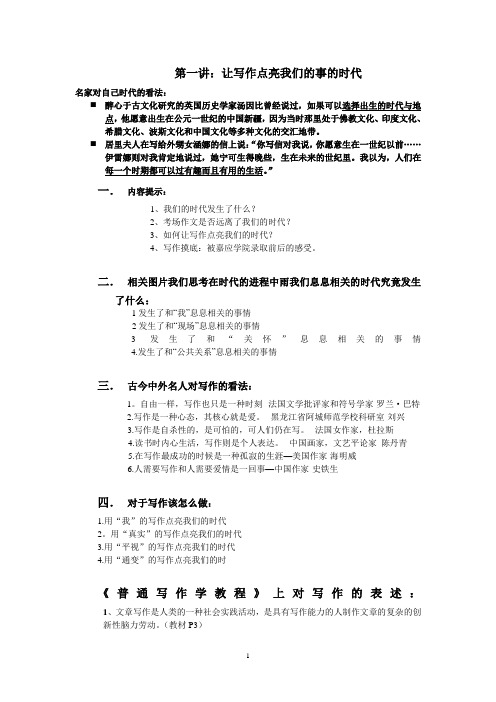
第一讲:让写作点亮我们的事的时代名家对自己时代的看法:⏹醉心于古文化研究的英国历史学家汤因比曾经说过,如果可以选择出生的时代与地点,他愿意出生在公元一世纪的中国新疆,因为当时那里处于佛教文化、印度文化、希腊文化、波斯文化和中国文化等多种文化的交汇地带。
⏹居里夫人在写给外甥女涵娜的信上说:“你写信对我说,你愿意生在一世纪以前……伊雷娜则对我肯定地说过,她宁可生得晚些,生在未来的世纪里。
我以为,人们在每一个时期都可以过有趣而且有用的生活。
”一.内容提示:1、我们的时代发生了什么?2、考场作文是否远离了我们的时代?3、如何让写作点亮我们的时代?4、写作摸底:被嘉应学院录取前后的感受。
二.相关图片我们思考在时代的进程中雨我们息息相关的时代究竟发生了什么:1发生了和“我”息息相关的事情2发生了和“现场”息息相关的事情3发生了和“关怀”息息相关的事情4.发生了和“公共关系”息息相关的事情三.古今中外名人对写作的看法:1。
自由一样,写作也只是一种时刻--法国文学批评家和符号学家-罗兰·巴特2.写作是一种心态,其核心就是爱。
--黑龙江省阿城师范学校科研室-刘兴3.写作是自杀性的,是可怕的,可人们仍在写。
--法国女作家,杜拉斯4.读书时内心生活,写作则是个人表达。
--中国画家,文艺平论家陈丹青5.在写作最成功的时候是一种孤寂的生涯—美国作家-海明威6.人需要写作和人需要爱情是一回事—中国作家-史铁生四.对于写作该怎么做:1.用“我”的写作点亮我们的时代2。
用“真实”的写作点亮我们的时代3.用“平视”的写作点亮我们的时代4.用“通变”的写作点亮我们的时《普通写作学教程》上对写作的表述:1、文章写作是人类的一种社会实践活动,是具有写作能力的人制作文章的复杂的创新性脑力劳动。
(教材P3)2.写作学是研究写作主体制作文章这一复杂的创造性脑力劳动的基本规律及方法的科学。
(教材P3)3.写作能力是大学生必须具备的一种能力……必须对学生进行知识、能力以及品德、审美的全面培养……写出格调高雅、文质兼美的文章来。
大学基础写作期末复习提纲

绪论1.什么是写作?2.谈谈你对写作的认识.3.总结一学期学习写作的收获(包括兴趣、意识、能力三方面),你计划第二学期如何继续提高写作能力?第一章散文1..如何理解散文概念的多种含义?古代散文含义:指的是散行单句的文章西方散文含义:指的是不分诗行不押韵的文章现代散文含义:指的是与诗歌、小说、戏剧并称的一种文学体裁(通常称为广义散文含义)当代散文含义:指的是短小精悍的记叙和抒情为主的散文(狭义散文)2.根据内容和表达方式的不同,可以把散文分成几类?各类散文有什么特点?记叙散文(记人叙事写景状物,表达方式以记叙描写为主,是散文的塔基)抒情散文(叙事抒情,借景抒情。
强调抒发作者的感情,表达方式也注意用抒情的散文,是散文的塔尖)议论散文(内容强调发表作者的见解,表达方式以形象议论为主的散文,侧重理智与看法)3.散文文体有哪些特征?题材广泛(核心特征)、个性鲜明、写法灵活、文情并茂、篇幅短小4.散文叙事有什么特点?非虚构性(能不能虚构是散文与小说的一个重要区别,抹杀了这个区别就等于抹杀了散文的特点)题材以小见大(对于散文来说,故事情节、冲突事件、诗的意境、固然是它的好题材,而那些小说、戏剧、诗歌也许不屑一顾的细琐、零碎、陋直、平凡,日常的小东西,也是它的好题材;散文擅长于写小题材,首先要选一些信息含量大信息价值高的小题材,而且要跟善于立意结合起来;许多好的文学作品常常是以小见大,而散文尤其看重这一点,在小题材里面蕴含着的内容和主题是思想深刻、旨趣高尚、感情纯挚、意境幽远的。
)个性鲜明(散文的内容都与作者直接相关,突出“我")清人王夫之说:“烟云泉石,花鸟苔林,金铺锦帐,寓意则灵"。
怎样理解这句话的意思?题材广泛,文情并茂5.散文的笔法叙事散文写法一事铺陈法——孙犁《报纸的故事》线索串事法——冯骥才《书桌》记人散文写法人物二三事法——鲁迅《藤野先生》景物散文写法状物特写法-—颜元叔《懒猫百态》抒情散文写法依事抒情法——巴金《怀念萧珊》象征散文写法象征寓情法-—鲁迅《秋夜》议论散文写法联类推理法--秦牧《面包和盐》第二章诗歌1.诗歌有哪些分类?按内容和表达方式分抒情诗和叙述诗主要关注朦胧诗(指运用象征、暗示、通感等手法,曲折地表现作者的思想和情感,主题朦胧多义的一种诗歌)舒婷《船》2.诗歌的特征有哪些?1)注重情感的抒发(诗贵有情,情感的激流推动着诗人的创作,他们不仅用抒情的方式放映生活、表达意愿,而且以抒情的方式打动教育读者;诗最怕无情,无情的诗徒具诗的外表,却没有诗的生命,就像人没有灵魂一样)2)注重意象的营造(诗歌的主题需要形象的表现,一首好诗,不讳徒具铿锵的外壳,也不会只有单调的说教)3)注重张力的扩充(一般我们把诗歌层面之间显示出来的聚合力叫做张力;首先要立意明晰,琦次要精心选材构象,再次要文字精美,形式精致)4)注重字句的锤炼(言简意深,耐人寻味是诗歌追求的一种艺术意境,在诗歌当中,每一个字,每一个句子应该是为了构成意象而存在的。
写作复习提纲

写作复习提纲一、名词解释1、间接描写:侧面描写,又叫间接描写,是从侧面烘托人物形象,是指在文学创作中,作者通过对周围人物或环境的描绘来表现所要描写的对象,以使其鲜明突出,即间接地对描写对象进行刻画描绘。
2、灵感思维:是指凭借直觉而进行的快速、顿悟性的思维。
它不是一种简单逻辑或非逻辑的单向思维运动,而是逻辑性与非逻辑性相统一的理性思维整体过程。
3、“无技巧”:所谓“无技巧”,实在是技巧高明到了没有斧凿之痕,不露技巧的痕迹,看不出用了什么技巧的地步,似拙实工,自然而然,这是功夫到家之后的随意挥洒,达到了“等闲拈出便超然”的艺术化境。
3、意识流:它既是一种文学创作的流派、手法,同时也是一种新的“叙述语言”。
它既不是“顺叙”也不是“倒叙”,更不是“插叙”,传统的这些“叙述语言”是合于“逻辑”的,具有“情节”(或不完整、不连贯),打破了时间与空间的种种藩篱,它把意识和下意识、理智和非理智,把现实和想象、真实和梦幻,把过去与未来,此地与彼地自然地“统一”起来了。
人物的“意识”流动变成了表现的中心。
5、气质:与生俱来的不依活动目的和内容为转移的典型的、稳定的心理活动特征。
6、调查采访:调查采访属于新闻学的范畴,指的是在新闻采访业务当中通过掌握更多的新闻线索和时间背景之后,记者与新闻当事人的采访交流,在调查采访中记着必须遵守新闻真实性的原则,做到事件报道的准确和及时和深入。
7、通感:通感修辞格又叫“移觉”,就是在描述客观事物时,用形象的语言使感觉转移,将人的听觉、视觉、嗅觉、味觉、触觉等不同感觉互相沟通、交错,彼此挪移转换,将本来表示甲感觉的词语移用来表示乙感觉,使意象更为活泼、新奇的一种修辞格。
8、预叙:在情节发展中对将来发生的事预先描述出来的叙述方法。
左传中也有此写法。
预先说出要发生的事,或预见事件的结果。
9、白描:以质朴的文字,抓住人物或事物的特征,寥寥几笔就勾勒出人物或事物形象的写法。
10、素材和题材:素材,一般是指作者在创作或写作前,通过观察、体验和感受,从生活中摄取来的、尚未经过取舍加工提炼的原始材料。
大学写作复习提纲(修改版)
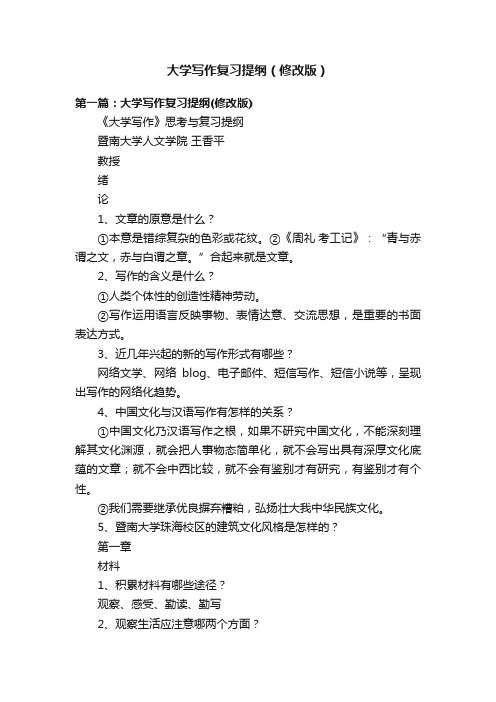
大学写作复习提纲(修改版)第一篇:大学写作复习提纲(修改版)《大学写作》思考与复习提纲暨南大学人文学院王香平教授绪论1、文章的原意是什么?①本意是错综复杂的色彩或花纹。
②《周礼 考工记》:“青与赤谓之文,赤与白谓之章。
”合起来就是文章。
2、写作的含义是什么?①人类个体性的创造性精神劳动。
②写作运用语言反映事物、表情达意、交流思想,是重要的书面表达方式。
3、近几年兴起的新的写作形式有哪些?网络文学、网络blog、电子邮件、短信写作、短信小说等,呈现出写作的网络化趋势。
4、中国文化与汉语写作有怎样的关系?①中国文化乃汉语写作之根,如果不研究中国文化,不能深刻理解其文化渊源,就会把人事物态简单化,就不会写出具有深厚文化底蕴的文章;就不会中西比较,就不会有鉴别才有研究,有鉴别才有个性。
②我们需要继承优良摒弃糟粕,弘扬壮大我中华民族文化。
5、暨南大学珠海校区的建筑文化风格是怎样的?第一章材料1、积累材料有哪些途径?观察、感受、勤读、勤写2、观察生活应注意哪两个方面?①观察要全面、精细、抓住特点②要经常培养3、有意感受与无意感受的区别何在?①无意感受是指主体随意的,既没有自觉的目的,也没有意识到本身的努力而获得的一种意外的感受。
②有意感受是主体自觉的、有预定目的的感受,它受主体意识和动机控制,是主体对客体刺激的集中注意。
4、科学家是否像文学家一样需要感受能力?请举例说明。
是。
如印度物理学家拉曼乘船经过地中海时,为美丽的大海陶醉了,他透过观察到的自然现象,认定深蓝色的海水是由于某种光散射引起的,由此发现了“拉曼效应”。
5、大学生应该怎样读书?①联系实际,有计划,有重点②结合专业③根据禀赋爱好兴趣④精读6、精读指的是怎样的阅读状态与效果?①精读是按顺序一字不漏地对阅读材料的仔细认读。
②不仅要“学求其训,句索其旨”,透彻理解所读内容,而且要在阅读时加强联想、分析、评价等思维活动,能够体会其情景,判断其真伪优劣。
③不仅要一字不漏地读,并且要将标点符号读进去,从而读出字里行间的语意来。
大学写作期末复习整理

《大学写作》复习大纲第一章主题1.掌握“主题”的含义及作用2.熟练掌握主题的要求,并能运用于写作实践之中正确、深刻、集中3.熟悉在写作实践中提炼、限制、深化主题的方法并能应用于写作实践中揭示事物的本质、规律;新颖,见人所不能见,发人所未曾发。
大处着眼,小处着手,以小见大。
挖掘其思想和理论深度,更具思想哲理深度,体现社会意义,更具现实指导作用4.了解“主题先行”与“意在笔先”的区别5.了解应用写作主题生成的两大特点第二章、材料1.了解材料的含义及其构成,并能区分材料与题材、素材等概念的区别2.了解应用写作的材料与文学写作的材料的四个不同特点3.了解搜集材料的方法,逐步积累写作材料4.熟练掌握选择材料的三个基本原则,并运用于写作和阅读实践中真实、典型、新颖5.掌握准确认识材料的性质与价值的方法,正确选择材料6.了解写作中运用材料的技巧,并能运用于写作实践中第三章、结构1.了解结构一词的含义及作用2.了解应用类文章与文学类文章在结构上的不同特点3.熟练掌握写作中锻炼思路的四种方法(包括开拓思路、组织思路的方法)拓展法、挖掘法、控制法、梳理法4.运用锻炼思路的知识有效地拓展、组织写作思路5.了解思路组织的要求,并能将有关知识熟练运用于写作和阅读实践。
6.掌握文章思路组织的几种常见模式,并能运用于写作实践之中。
第四章、语言1.熟悉语言对于写作的重要性,锤炼良好的写作语言2.熟悉汉语写作的语言资源,熟悉文言、现代汉语、方言俗语三种不同语言资源的长处与短处,并能有效地加以整合,根据不同文体的写作要求熟练地使用写作语言3.了解积累写作语言的方法,熟悉“内语言”、外语言“的概念。
内语言:指写作者的内在语言,它存在于写作者的思维、感悟体验之中,表现在文章中,则体现为文章语感、文气、情调(如哀婉、高亢、激昂、幽默、诙谐、达观、悲戚等等)。
外语言:指写作者外在的语言表现,体现为作者对字、词、句、标点符号选择、使用方面。
大学写作复习提纲

一、主题的要求〔一〕主题在文章中的地位及作用重要地位、主导作用①决定着作品确实立及深化②决定着作品的精神品格的层次③决定文章体裁和表达方式④决定如何选择和剪裁文章的材料⑤才有可能形成趋向完整的写作思路⑥才有可能将意化的思维转化为物化的作品〔二〕主题的根本要求:正确、深刻、集中①立意要正确②提炼主题要深刻关键:写作者的见识主题的新颖:新认识、新观点、新开掘、新角度把握事物特征:横向思维〔由此及彼,类比联想〕、纵向思维〔纵深推究其原因〕、逆向思维〔联想反面〕③反映主题要集中〔一篇文章只有一个写作主旨〕(三)不同文体对主题的要求刻画人物:开掘人物思想性格叙事:探求事件思想意义,找本质景物:情及意〔渲染气氛、交代背景、寄情寓意〕论说性文章:抓主要矛盾并将其作为认识及解决问题的出发点实用性文章主题特点:①写作的受命性②写作者的群体性③写作目的的实用性根本要求:正确、准确、单纯二、材料的选择和使用要考虑到文章的思想内容和构造形式的实际需要①符合主题表现的需要,围绕主题中心使用材料②考虑到怎样才会使文章的构造形式更完美、更具有个性化魅力(一)材料的选择搜集材料:多;选择材料:严选材原那么:①真实真实:指材料符合生活的实际情况,反映客观事物本身的本质和变化生活的真实:实际存在的一切具体的生活现象〔应用性文章〕艺术的真实:对生活真实的提炼、加工及变形〔文学作品〕艺术真实在外表上可以近似于生活真实,但比生活真实更理想、更集中、更典型、更具有普遍性。
②典型:最有代表性、最能反映本质、最能说明问题、最能突出人物思想品质和鲜明反映事物精神面貌的材料。
围绕中心。
③新颖:新鲜、活泼、独特,使人耳目一新,有所收获的材料。
选别人不写、少写的材料,广为人知的材料换新视角。
(二)材料的使用①材料的剪裁:选择最能突出表现主题的那一局部,放弃及之有关但不密切的材料②材料的聚合:分清主次,分清材料及主题和构造的关系,以便于决定如何组合及排列,安排在文章中的出场次序。
大学写作复习资料
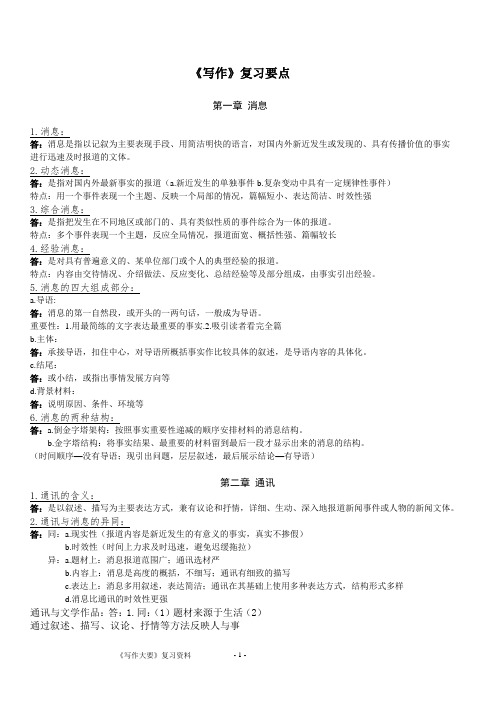
《写作》复习要点第一章消息1.消息:答:消息是指以记叙为主要表现手段、用简洁明快的语言,对国内外新近发生或发现的、具有传播价值的事实进行迅速及时报道的文体。
2.动态消息:答:是指对国内外最新事实的报道(a.新近发生的单独事件b.复杂变动中具有一定规律性事件)特点:用一个事件表现一个主题、反映一个局部的情况,篇幅短小、表达简洁、时效性强3.综合消息:答:是指把发生在不同地区或部门的、具有类似性质的事件综合为一体的报道。
特点:多个事件表现一个主题,反应全局情况,报道面宽、概括性强、篇幅较长4.经验消息:答:是对具有普遍意义的、某单位部门或个人的典型经验的报道。
特点:内容由交待情况、介绍做法、反应变化、总结经验等及部分组成,由事实引出经验。
5.消息的四大组成部分:a.导语:答:消息的第一自然段,或开头的一两句话,一般成为导语。
重要性:1.用最简练的文字表达最重要的事实.2.吸引读者看完全篇b.主体:答:承接导语,扣住中心,对导语所概括事实作比较具体的叙述,是导语内容的具体化。
c.结尾:答:或小结,或指出事情发展方向等d.背景材料:答:说明原因、条件、环境等6.消息的两种结构:答:a.倒金字塔架构:按照事实重要性递减的顺序安排材料的消息结构。
b.金字塔结构:将事实结果、最重要的材料留到最后一段才显示出来的消息的结构。
(时间顺序—没有导语;现引出问题,层层叙述,最后展示结论—有导语)第二章通讯1.通讯的含义:答:是以叙述、描写为主要表达方式,兼有议论和抒情,详细、生动、深入地报道新闻事件或人物的新闻文体。
2.通讯与消息的异同:答:同:a.现实性(报道内容是新近发生的有意义的事实,真实不掺假)b.时效性(时间上力求及时迅速,避免迟缓拖拉)异:a.题材上:消息报道范围广;通讯选材严b.内容上:消息是高度的概括,不细写;通讯有细致的描写c.表达上:消息多用叙述,表达简洁;通讯在其基础上使用多种表达方式,结构形式多样d.消息比通讯的时效性更强通讯与文学作品:答:1.同:(1)题材来源于生活(2)通过叙述、描写、议论、抒情等方法反映人与事2.异:(1)通讯反映的是新闻的事实(2)文学作品反映的是艺术的真实3.风貌通讯的含义:(散文体的通讯)答:是报道某个地方、单位、行业的新面貌或者地方物产、风俗习惯、重要建筑等等的通讯。
大学应用文写作复习提纲
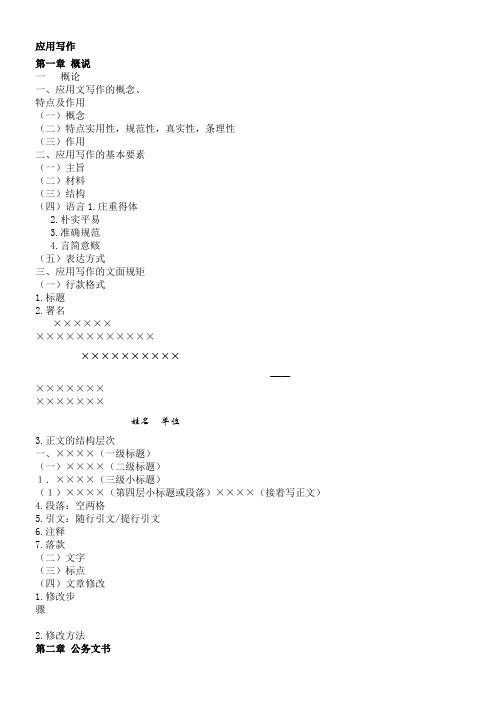
应用写作第一章概说一概论一、应用文写作的概念、特点及作用(一)概念(二)特点实用性,规范性,真实性,条理性(三)作用二、应用写作的基本要素(一)主旨(二)材料(三)结构(四)语言1.庄重得体2.朴实平易3.准确规范4.言简意赅(五)表达方式三、应用写作的文面规矩(一)行款格式1.标题2.署名××××××××××××××××××××××××××××——××××××××××××××姓名单位3.正文的结构层次一、××××(一级标题)(一)××××(二级标题)1.××××(三级小标题)(1)××××(第四层小标题或段落)××××(接着写正文)4.段落:空两格5.引文:随行引文/提行引文6.注释7.落款(二)文字(三)标点(四)文章修改1.修改步骤2.修改方法第二章公务文书一概说(一)公文概念和特点(二)种类下行文:命令、决定、公告、通告、通报、批复上行文:请示、报告平行文:议案通用类型:通知、意见、函、会议既要(三)格式(1)公文标题•标准式标题:发文机关+事由+文种•双项式标题:发文机关+文种事由+文种•转文式标题:发文机关+被批转的文件的标题+文种(2)主送机关(3)正文(4)附件(5)成文时间(6)公文生效标识(7)附注3.版记部分(1)主题词类别词+类属词+文种(2)抄送(3)印发机关和印发时间(4)版记中的反线二下行文1.命令2.决定3.公告4.通告5.通报6.批复:用途:答复下级请示事项格式:引语正文结语三上行文1.请示分类:请求指示/审核/批准/解决要求:按级请示一文一事切忌与报告混淆格式:缘由/内容/结语2.报告报告和请示:性质/目的要求/行文时限/内容不同格式:工作/情况/答复/建议/报送报告四平行文议案五通用类型1.通知格式:指示性通知:发文原因/目的,过渡语/通知的具体事项/执行要求批转性通知: “××××同意××××《××××》,现转发给你们,请遵照执行。
《实用文体写作知识》总复习

<实用文体写作知识>复习参考资料一、填空题练习⑴主旨、材料、结构和语言是一切文章的构成要素。
⑵按照行文关系和行文方向的不同,可将公文分为上行文、平行文和下行文三种。
上行文是指下级机关向所属上级机关呈送的公文,主要有报告、请示等;平行文是指想同级机关或不相隶属的机关送交的公文,主要有函等;下行文是指上级机关向下级机关发送的公文,主要有命令(令)、决定、通报、通知、批复、意见等。
按照秘密等级不同分绝密文件、机密文件、秘密文件⑶公布社会个有关方面应当遵守或者周知的事项,要用通告;批转下级机关的公文,转发上级机关和不相隶属机关的公文,传达下级机关办理和需要有关单位周知或者执行的事项,任免人员,要用通知;表彰先进,批评错误,传达重要精神和情况,要用通报。
⑷按性质和内容的不同,可将总结分为综合性总结和专题性总结两类。
⑸经济活动分析报告的功能主要包括:诊断功能、建议功能、反馈功能、预测功能。
⑹事实和理由是民事起诉状的核心内容。
⑺按其内容和功用的不同,可将常用的通知分为:批示性通知、指示性通知、告知性通知、任免性通知几种。
⑻报告和请示的区别主要体现为:具体功用不同、内容含量不同、行文时机不同。
⑼消息的开头部分通常被称作导语。
⑽书信的内文主要包括称谓、问候语、正文、祝颂语和落款等几个部分。
⑾向上级机关汇报工作,反映情况,答复上级机关的询问,要用报告;向上级机关请求指示、批准,要用请示。
⑿会议纪要所应具备的两大特点是:纪实性、提要性。
会议纪要分为指示性会议纪要,通报性会议纪要和消息性会议纪要三类。
⒀常见的规章制度主要有章程、条例、规定、办法、和守则几种。
⒁民事起诉状通常是由首部、正文和尾部三部分组成。
⒂按用途和内容的不同可以将启事问为征招类启事、寻觅类启事、声明类启事三种。
⒃在公文中表示公文内容特征和归属类别的关键性词语叫主题词,一般不能超过7个词。
⒄通告可以分为两类:法规性通告和事务性通告。
⒅经济新闻的特点主要体现在真、新、精几个方面。
- 1、下载文档前请自行甄别文档内容的完整性,平台不提供额外的编辑、内容补充、找答案等附加服务。
- 2、"仅部分预览"的文档,不可在线预览部分如存在完整性等问题,可反馈申请退款(可完整预览的文档不适用该条件!)。
- 3、如文档侵犯您的权益,请联系客服反馈,我们会尽快为您处理(人工客服工作时间:9:00-18:30)。
同济大学实用写作期末复习提纲CHAPTER ONE1.The conciseness, clarity, correctness and courteousness are very important.2.There are two general types of workplace document, those that try to either inform thereader about a product or service or persuade the reader that this product or service is a good one and worth buying.3.The workplace writer chooses content and language which will best achieve their aim.4.As with any form of communication, the most important factors in business communicationare purpose and audience.5.The status of the people sending and receiving the communication includes bottom-upcommunication, top-down communication and sideways communication.CHAPTER TWO1. A memo is used only for communication within a company, i.e. it is an intra-companydocument and is not used for inter-company communication.2. A memo may be distributed top-down or bottom-up.ing first person words like ‘we’, ‘I’ and ‘our’ and second person words like ‘you’ and ‘your’reduces the distance between the sender and receiver. Junior employees writing to senior employees can use these words, but they need to be careful that the right distance, and therefore courtesy, is maintained.●Title(MEMORANDUM), Heading(To, From, Date, Subject), Body(Purpose, Background,Request)CHAPTER THREE1.Letters of request are written to seek information and to obtaina response to a specificenquiry.2.Letters responding to requests give information but also attempt to build goodwill.●Block formatThe main feature of this format is that everything (with the possible exception of the company’s letterhead and logo) is blocked or justified to the left side of the page. With this style, it is not necessary to use commas or full stops in the date, address, salutation, or close.●SalutationIf you know the name of your recipient, begin Dear Mr. or Ms. X and closeYours sincerely; if you do not know the recipient or their gender, begin Dear Sir/Madam and close Yours faithfully.CHAPTER FOUR1.Letters of complaint normally include the following information: an explanation of theproblem, the consequences of the problem for both parties and a request to solve the problem.2. A letter of adjustment will normally include the following information in the given order: anoffer of apologies,a summary of action taken to rectify the problems and an assurance ofgoodwill including the offer of compensation, if appropriate.CHAPTER SIX1.Abusiness report is divided into numbered section: introduction, procedure, findings,conclusion and recommendations.2. A business report is written because information which has been gathered needs to bepresented in an organized way. The length and format depends on the purpose of the report, the content and the intended audience or reader.●VoicesThe function of the passive voice is to make the information sound objective and impersonal, to remove any hint of personal bias.●TensesTo show the relevance of the information, writers often use the S. Pr. T. as the ‘default tense’, especially for the introduction and conclusion sections. Exceptions to this are when an event clearly took place in the past.CHAPTER EIGHT1.It is very important, but also quite difficult, to get the tone and style right in job applicationletters.2. A resume always contains particular information in sequence and under certain headings:career objective, personal data, education and qualifications, employment record, extracurricular activities and awards, special skills, hobbies and sports and referees.3.The most important language feature of a resume is its simplicity.●Application LetterSpecifying the job being applied for, relating studies to job demands, mentioning relevant part-time work, referring reader to the resume, mentioning the qualities developed through project work, stating reasons for applying to this particular company, showing knowledge of company’s plans, linking language skills to company’s plans and giving contact details and stating available for interviewCHAPTER TEN1.Minutes of a meeting are written for two main purposes: to create a record of what tookplace in the meeting and to remind those at the meeting of the actions they need to take after the meeting.2.Whatever the length, minutes always include the time and date of the meeting, the name ofall those present and absent, the agenda items discussed and all decisions reached and the time at which the meeting ended.3.When writing minutes, we need to use reported speech.CHAPTER TWELVE1.We persuade others in three main ways: appeal to reason, appeal to emotions and appeal totrust.CHAPTER THIRTEEN●Introduction, body and conclusion●Sales(pl.)●Grow, ascend, mount, soar, level up, shoot up, boom●Descend, plunge, plummet, slump, skid, tumble, level down, bottom out●Flatten out, reach a plateau, remain, maintain, keep, stay, be the same as, be similar to, leveloff/outCHAPTER FOURTEEN1.Business proposals are written to suggest new ideas for organizing a company to make itmore efficient or for promoting its products and services in a more effective way.2.To be practical, there are five areas in which an idea needs to work:the technical,theresource-related, the financial, the social and the environmental.CHAPTER SIXTEEN1. A company profile provides prospective clients and customers with what the companyconsiders to be key information about the organization. This will normally include: facts and figures about its major products and services, the history and development of the company, its mission and philosophy, a statement of identity and a projection of its preferred image.2. A company profile has both informational and promotional purposes.。
